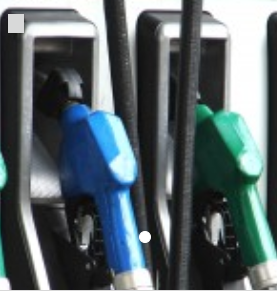The national average for a gallon of gas fell 4 cents since last week to $3.38. The main reason is the oil price, which fell into the mid $70s/barrel, nearly $5 cheaper than a week ago.
“The cost for oil accounts for 55% of what we pay at the pump,” said Lori Weaver Hawkins, public affairs manager, AAA Blue Grass. “Higher or lower oil costs will play a major role in the price we pay when fueling up.”
According to new data from the Energy Information Administration (EIA), gas demand increased slightly from 8.27 million b/d to 8.91 million b/d last week. Meanwhile, total domestic gasoline stocks decreased by 1.8 million bbl to 240.1 million bbl last week. However, fluctuating oil prices have contributed to pushing pump prices lower. But if gas demand keeps rising amid tightening domestic stocks, drivers may see an end to future pump price drops.

Today’s national average of $3.39 is three cents less than a month ago and 14 cents less than a year ago.
Today’s average in Kentucky dropped another penny overnight, now at $3.01. That’s 5 cents lower than one week ago. Today’s average is 17 cents less than a month ago and 21 cents less than a year ago.
The average gas price in Lexington has lagged behind the drop in prices at the state level, but also dropped a penny overnight to land at $3.04.
Lexington’s current gas price average is 4 cents lower than the average one week ago and 12 cents lower than a month ago. Today’s price is 17 cents lower than a year ago.
Ashland’s average gas price dropped a penny overnight as well, currently $3.16. That’s 8 cents less than the average a week ago. Ashland’s average price is trending about 12 cents lower than a month ago and 7 cents higher than a year ago.
Around the Commonwealth, the highest county-level average gas price can be found in Rockcastle County at $3.20. The cheapest county-wide average price of gasoline in the commonwealth can be found in Robertson County, averaging $2.81.
Checking nearby, the average price for a gallon of regular today in Ohio is at $3.17, West Virginia $3.29, Virginia $3.17, Tennessee $3.04, Indiana $3.25, Illinois $3.56 and Missouri $3.02.
Across the nation, the high spot is Hawaii, now averaging $4.87 for a gallon of regular. California follows at $4.75.
The low spot in the nation can be found in Texas, averaging $2.95 for a gallon of regular.

Quick Stats
• Since last Friday, these states have seen the largest changes in their averages this week: Ohio (−10 cents), Tennessee (−9 cents), New Jersey (−8 cents), Iowa (−8 cents), Virginia (-8 cents), Delaware (-8 cents), Maryland (-7 cents), Wisconsin (−7 cents), Texas (-7 cents), Nebraska (-7 cents), Rhode Island (−6 cents), Oklahoma (-6 cents), Washington DC (-6 cents), Rhode Island (-6 cents), Alabama (−6 cents), North Carolina (-6 cents) and Georgia (-6 cents).
• The nation’s top 10 least expensive markets: Texas ($2.95), Mississippi ($2.98), Kentucky ($3.02), Missouri ($3.02), Arkansas ($3.03), South Carolina ($3.04), Alabama ($3.04), Tennessee ($3.04), Oklahoma ($3.06) and Louisiana ($3.07).
Oil Market Dynamics
At the close of Wednesday’s formal trading session, WTI decreased by $2.41 to settle at $73.95. Crude prices have declined due to the strengthening of the dollar and market concerns about increasing domestic oil inventories. An increase in supply could mean that demand may not move as high as anticipated. EIA reported that total domestic commercial crude inventories increased substantially by 7.6 million bbl to 479 million bbl last week.
Get the most out of every gallon
AAA offers the following advice to help drivers save at the pump:
• A vehicle that’s been maintained will help you maximize your miles per gallon. Make routine vehicle inspections a part of your regular routine. Plus, here’s a step you can take on your own: make sure your tires are properly inflated. Underinflated tires are a drag on fuel economy. Check tire pressure at least weekly during times of fluctuating temperatures.
• Find the shortest route to your destination and map it out before you go to minimize unnecessary turnarounds, idling and backtracking. Avoid peak traffic times because you get zero miles to the gallon when you’re sitting still in traffic. If possible go to “one-stop shops” where you can do multiple tasks (banking, shopping, etc.).
• Fuel economy peaks at around 50 mph on most cars, then drops off as speeds increase. Reducing highway speeds by 5 to 10 mph can increase fuel economy by as much as 14%. Surpassing the posted speed limit is not only against the law and increases the risk of crash severity, but also reduces your gas mileage.
• A car engine consumes one quarter to one-half gallon of fuel per hour when idling, but a warm engine only takes around 10 seconds worth of fuel to restart. Where safe to do so, shut off your engine if you will be stopped for more than a minute. Remember, idling gets you 0 miles to the gallon.
• When traveling, use “fast pass” or “express” toll lanes to avoid unnecessary stops or slowdowns on the highway.
• Only use premium gas in vehicles that recommend or require it. Paying for premium gas for a vehicle that takes regular is a waste of money and is of no benefit to the vehicle.





















